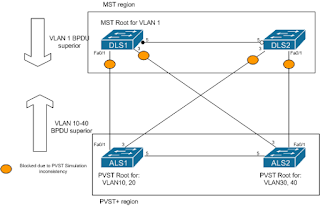There is a lot of confusion around how E1 and E2 routes are handled in OSPF, especially in the area of path selection and the path chosen to the ASBR.
What is an External (Type-5) LSA?
Prefixes injected into OSPF by an Autonomous System Boundary Router (ASBR) in a non-stub area are represented by Type-5 LSAs in OSPF. The Type-5 LSA contains the prefix, the advertising ABSR and a redistributed metric value and type. These prefixes are considered to be "External" in OSPF and can be one of two sub-types, that vary only in the way that the ASBR is selected:- External Type 2 (E2) - the metric that is contained in the LSA (set at the time of injection) is the primary metric that is taken into account (but not the only one, as we will see).
- External Type 1 (E1) - the metric that is contained in the LSA (set at the time of injection) is taken into account as well as the cost to reach the ASBR calculated by the OSPF process.
Type-4 LSA
A Type-4 LSA is generated when an ABR floods a Type-5 LSA into another area. The Type-4 LSA contains the cost of reaching the ASBR via that ABR. Other routers in the area use Type-4 LSAs when calculating the path cost to the ASBRs and to know which ASBRs are available via which ABRs.
OSPF Path Selection Hierarchy
In terms of how OSPF makes a choice between different LSA types when it comes to path selection, it uses the following hierarchy:
- Intra-Area (O)
- Inter-Area (O IA)
- External Type 1 (E1)
- External Type 2 (E2)
- NSSA Type 1 (N1)
- NSSA Type 2 (N2)
However, the forwarding metric to the ABSR is still calculated in the case of both E1 and E2 routes, since, even for an E2 route, the least cost path to the ASBR must still be determined just like any other network!
So you can see that an E1 route would be chosen over an E2 route. So far so good. But how would a router make a decision over two External routes of the same type for the same prefix? Which ASBR is chosen?
For E1 routes, this is where the cost to the ASBR (the forward metric) is added to the redistributed cost assigned at the ASBR. Lowest cost wins.
For E2 routes, the first consideration is the cost assigned at redistribution (i.e. the one contained in the LSA) - lowest cost wins. If these costs are equal, then the lowest cost path (lowest forward metric) to the nearest ASBR advertising the prefix is chosen.
Note that this can even lead to ECMP behaviour and per-flow load-sharing where the costs to an ASBR (or more than one ASBR) are equal, which might not be the behavior you expect or even desire.
Where should I use E1 and where should I use E2?
Single exit point
While it is true that E1 routes require more processing (since the forwarding metric is calculated) just using E2 routes (which are the Cisco default) because it's easiest not to think about it is not a really good design philosophy. You need to consider the possibility of growth and network changes and whether your choice now will have implications later.
Multiple exit points
In the case of E2, then the redistributed metric becomes the first criterion for ASBR selection (somewhat like local preference in BGP) and the lowest redistributed metric will become the preferred outbound path, regardless of the forward metric to the ASBR. This can be useful if there is a preference as to which ABSR should be used for a given prefix. In the case where the same metric is assigned, then the forwarding decision will be made on the basis of the forward metric, which, as I mentioned above, result in less deterministic behaviour.
Summary
In summary:
- Type-5 (External) LSA E1 and E2 metrics simply determine the selection of ASBR,
- In the case of a tie between two E2 routes with the same metric, the internal path cost is used to break the tie.
- Regardless of whether type E1 or E2 routes are used in redistribution, the internal cost of the route to the ASBR determines the path taken by traffic destined for that network.
- In cases where there are multiple exit points (ABSRs) advertising the same prefix, be careful in the selection of External path type (E1 or E2). E2 can be used to your advantage if tight control over preferred outbound routing paths is required.
Please also see the excellent INE blog article on OSPF External Path selection, which clarifies many of the confusing issues around E1 and E2 routes.
